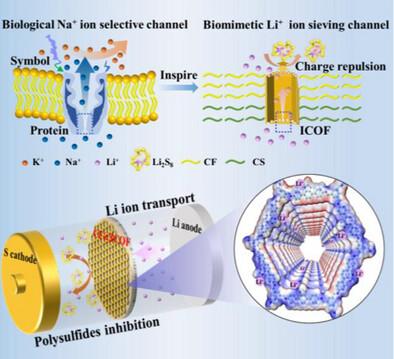Biomimetic Ultrathin Cellulose Composite Separators for High-Performance Lithium–Sulfur Batteries
IF 19
1区 材料科学
Q1 CHEMISTRY, MULTIDISCIPLINARY
引用次数: 0
Abstract
Lithium–sulfur (Li–S) batteries are considered promising candidates for next-generation energy storage systems due to their high energy density and low cost. However, their commercial production is impeded by the lithium polysulfides (LiPSs) shuttle effect and lithium dendrite growth, which degrade capacity and cycling stability. Inspired by the selectivity of biological ion channels, an ultrathin (8 µm) cellulose composite separator with high ion selectivity and permeability is developed by leveraging the compatibility of chitosan (CS) to cellulose fiber (CF) with covalent organic frameworks (COFs), promoting the self-assembly of COFs with a preferred (100) orientation. The resulting biomimetic bilayer CF@ICOF exhibits a high lithium-ion flux (2.186 mS cm−1) and exceptional Li+/S62− selectivity (275.97), effectively suppressing both the LiPSs shuttle and lithium dendrite formation. As a result, the Li–S battery utilizing the CF@ICOF separator delivers ultra-stable cycling performance, with a capacity decay of only 0.047% per cycle over 800 cycles at 0.5C. Even with a high sulfur-loaded cathode (11.12 mg cm−2) and a lean electrolyte (3.5 µL mg−1), the battery retains over 92.73% capacity after 200 cycles. Moreover, a flexible pouch cell is integrated into a wearable display system, demonstrating both high energy density (440.98 Wh kg−1) and excellent stability.

高性能锂硫电池用仿生超薄纤维素复合材料分离器
锂硫(li -硫)电池因其高能量密度和低成本而被认为是下一代储能系统的有希望的候选者。然而,它们的商业化生产受到多硫化锂(LiPSs)穿梭效应和锂枝晶生长的阻碍,从而降低了容量和循环稳定性。受生物离子通道选择性的启发,利用壳聚糖(CS)与纤维素纤维(CF)与共价有机骨架(COFs)的相容性,促进COFs在首选(100)取向上的自组装,开发了一种具有高离子选择性和渗透性的超薄(8µm)纤维素复合材料分离器。该仿生双层膜CF@ICOF具有较高的锂离子通量(2.186 mS cm−1)和优异的Li+/S62−选择性(275.97),有效抑制了lips穿梭和锂枝晶的形成。因此,使用CF@ICOF隔膜的Li-S电池提供了超稳定的循环性能,在0.5C下进行800次循环时,每次循环的容量衰减仅为0.047%。即使使用高含硫阴极(11.12 mg cm - 2)和稀薄电解质(3.5 μ L mg - 1),电池在200次循环后仍保持超过92.73%的容量。此外,柔性袋状电池集成到可穿戴显示系统中,具有高能量密度(440.98 Wh kg−1)和优异的稳定性。
本文章由计算机程序翻译,如有差异,请以英文原文为准。
求助全文
约1分钟内获得全文
求助全文
来源期刊

Advanced Functional Materials
工程技术-材料科学:综合
CiteScore
29.50
自引率
4.20%
发文量
2086
审稿时长
2.1 months
期刊介绍:
Firmly established as a top-tier materials science journal, Advanced Functional Materials reports breakthrough research in all aspects of materials science, including nanotechnology, chemistry, physics, and biology every week.
Advanced Functional Materials is known for its rapid and fair peer review, quality content, and high impact, making it the first choice of the international materials science community.
 求助内容:
求助内容: 应助结果提醒方式:
应助结果提醒方式:


